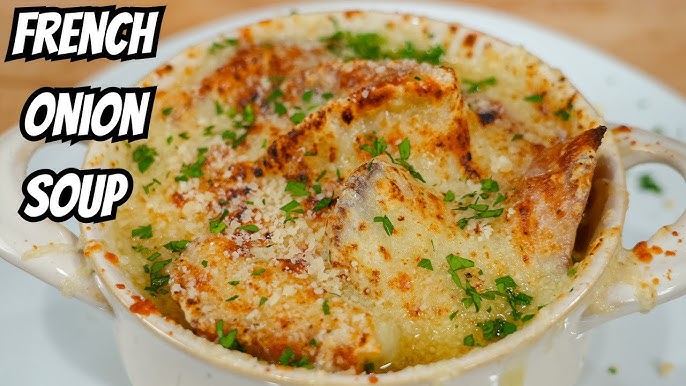Best French Onion Soup Recipe: French Onion Soup has a long and flavorful history dating back to the 18th century in France. Traditionally known as “Soupe à l’Oignon Gratinée,” it was once considered a humble peasant dish. Onions were cheap, easy to store, and abundant, making them a go-to ingredient for rural households. But what made the soup special was the slow caramelization process and the use of stale bread and cheese to add richness. Over time, the dish gained fame in Parisian restaurants and eventually made its way around the world. Today, it’s a symbol of rustic French cuisine and comfort food at its finest.
Why It’s a Beloved Classic
So, what makes French Onion Soup such a crowd-pleaser? It’s that beautiful contrast—sweet, deeply caramelized onions in a savory broth, topped with a crunchy, cheesy slice of baguette. It’s hearty, soul-warming, and indulgent. Whether you’re looking for a cozy dinner on a cold night or a starter for a French-themed dinner party, this soup never fails to impress. It’s also incredibly versatile—dress it up with gourmet cheese or keep it simple and traditional.
Key Ingredients for Authentic Flavor
Best Type of Onions to Use
Not all onions are created equal when it comes to French Onion Soup. For the most authentic, slightly sweet flavor, yellow onions are the gold standard. They strike the perfect balance between sweet and savory once caramelized. You can also mix in a few red onions or shallots for extra depth, but steer clear of white onions—they tend to be sharper and less sweet, which can throw off the flavor profile. Aim for about 2-3 pounds of onions for a pot of soup that serves four to six.
Slice them thinly and evenly to ensure they cook uniformly. The key here is patience—good things take time, and so do perfectly caramelized onions.
Choosing the Right Broth
The broth is just as important as the onions. A rich, flavorful beef broth is traditional and gives the soup its signature depth. Homemade is ideal, but a high-quality store-bought version can work in a pinch. If you’re going vegetarian, you can opt for a deeply roasted vegetable broth, but keep in mind it won’t have quite the same richness.
Want to level up? Add a splash of white wine or dry sherry to deglaze the pan after caramelizing the onions. It adds acidity and complexity to the flavor.
Bread and Cheese – The Topping Matters
The crowning glory of any French Onion Soup is the toasted baguette slice and bubbling cheese topping. Go for a crusty French baguette, sliced about ½ inch thick. As for the cheese—Gruyère is king. It melts beautifully and has a nutty, slightly salty flavor that complements the soup perfectly. Swiss cheese, Comté, or even provolone are good substitutes if Gruyère is out of reach.
Toast the bread before placing it on the soup, so it doesn’t turn soggy. Then generously pile on the cheese and broil it to golden, bubbly perfection.
Kitchen Tools You’ll Need
Must-Have Utensils and Cookware
Before diving into the cooking, let’s talk tools. You don’t need a gourmet kitchen to whip up a restaurant-quality French Onion Soup, but having the right equipment will make your life a whole lot easier:
- Heavy-bottomed soup pot or Dutch oven – Essential for evenly caramelizing onions.
- Wooden spoon or silicone spatula – Helps scrape up those delicious brown bits without damaging your pot.
- Chef’s knife – For slicing onions thin and evenly.
- Cutting board – A sturdy surface for safe slicing.
- Oven-safe soup bowls or ramekins – For the final broil with cheese.
- Baking sheet – To toast the bread slices in the oven.
A kitchen torch can also come in handy if you want to get that cheese extra melty and golden without using the broiler. Optional, but fun!
How to Make Best French Onion Soup – Step-by-Step Instructions
Step 1: Slicing and Caramelizing Onions
This is where the magic starts. Slice your onions thinly and uniformly—this ensures even cooking. In a large, heavy-bottomed pot or Dutch oven, melt 2-3 tablespoons of unsalted butter over medium heat. Add the onions along with a pinch of salt to help draw out moisture. Cook them slowly, stirring frequently. First, they’ll turn translucent, then golden, and finally deep brown. This process takes 40 to 60 minutes—don’t rush it!
If the onions start to stick, you can add a splash of water to deglaze the pot and scrape up the fond (those flavorful browned bits). The caramelization step is critical—it’s what gives the soup its deep, sweet-savory flavor.
Step 2: Deglazing and Building Flavor
Once your onions have reached that rich, golden-brown stage, it’s time to deglaze the pan. This step lifts all the flavor-packed bits stuck to the bottom. Pour in about ½ cup of dry white wine, dry sherry, or even a bit of brandy—whatever you have on hand that can add a bit of depth. Scrape the bottom of the pot as the alcohol cooks off, about 2-3 minutes.
Next, stir in a tablespoon of flour. This helps thicken the soup ever so slightly, making it feel more substantial. Cook the flour for a minute to eliminate the raw taste. Then, pour in your beef broth—about 6 to 8 cups depending on how many people you’re serving. Add bay leaves, fresh thyme, salt, and cracked black pepper. Let everything simmer together for about 30–40 minutes so all the flavors meld.
Optional additions include a splash of Worcestershire sauce for umami or a dash of balsamic vinegar for a touch of acidity.
Step 3: Simmering the Soup
This is where patience continues to pay off. With all your ingredients in the pot, reduce the heat and allow the soup to simmer gently for 30–40 minutes. Stir occasionally and adjust the seasoning as needed. You want to taste the sweetness of the onions balanced with the savory richness of the broth.
This stage isn’t just about cooking—it’s about developing deep, complex flavors. The broth will thicken slightly, and the aroma will fill your kitchen. If you want an even richer texture, you can simmer the soup uncovered to allow it to reduce a bit more. Just keep an eye on it so it doesn’t over-concentrate.
Once done, fish out the bay leaves and thyme stems, and you’re ready for the best part—serving it up with the cheesy bread.
Step 4: Toasting the Bread
While your soup is simmering, now’s the perfect time to prep the topping. Slice a French baguette into ½-inch thick rounds. Lightly brush each side with olive oil or melted butter, and toast them in the oven at 375°F (190°C) for about 8–10 minutes, flipping halfway through. They should be golden brown and crisp, ready to stand up to the soup without turning soggy.
Want a flavor boost? Rub the toasted slices with a clove of garlic after they come out of the oven. This little touch makes a big impact in the final dish.
Make enough slices for one or two pieces per bowl of soup. If you’re planning leftovers, you can store the toasts separately and re-toast them before serving again.
Step 5: Assembling and Broiling
Here comes the grand finale. Ladle your hot, fragrant soup into oven-safe bowls or crocks, leaving some space at the top. Float a slice (or two) of toasted baguette on the surface, then cover generously with shredded Gruyère cheese.
Place the bowls on a baking sheet and broil them under high heat for 2–4 minutes—just until the cheese is melted, bubbling, and beautifully golden brown. Keep a close eye to avoid burning. Alternatively, use a kitchen torch for that fancy finishing touch.
Once done, carefully remove the bowls (they’ll be HOT!) and let them cool for a minute before serving. The cheese will form a savory crust, the bread will soak up just enough broth, and every spoonful will be pure comfort.
Tips for the Perfect French Onion Soup
Common Mistakes to Avoid
Even though this soup seems simple, a few missteps can impact its flavor and texture:
- Undercooked onions: Caramelizing onions takes time. Don’t rush this process or you’ll miss out on that deep, sweet flavor.
- Using low-quality broth: Since the broth is the base, it needs to be rich and flavorful. A bland broth means a bland soup.
- Overloading the cheese: Yes, we all love cheese, but too much can overpower the soup and make it greasy. Balance is key.
- Skipping the toasting: Never skip toasting the bread, or you’ll end up with a soggy mess.
- Improper seasoning: Taste as you go. A splash of vinegar or a bit more salt can make all the difference.
How to Store and Reheat Leftovers
Making the Most of Your French Onion Soup
Got leftovers? Lucky you! French Onion Soup actually develops even more flavor overnight, making it an ideal make-ahead meal. But there’s a method to storing and reheating if you want to enjoy that same rich, comforting experience the next day.
Storage Tips:
- Let the soup cool completely before transferring it to an airtight container.
- Store the broth and onions separately from the bread and cheese to prevent sogginess.
- You can keep the soup in the fridge for up to 4 days. For longer storage, freeze it without the bread and cheese topping.
Reheating Tips:
- Reheat the soup on the stovetop over medium-low heat. Stir occasionally to prevent sticking.
- For a quick option, use the microwave—just heat in 30-second bursts, stirring in between.
- While the soup reheats, toast fresh slices of bread and top with cheese. Broil or torch them before adding to the hot soup.
- If you’re reheating a fully assembled bowl, use the oven to keep the bread crispy and the cheese gooey.
Trust us, day-two French Onion Soup is just as heavenly—maybe even more.
Serving Suggestions and Variations
What to Serve With It
French Onion Soup is rich and flavorful, so you don’t need anything too heavy on the side. But if you’re looking to complete the meal, here are a few winning combos:
- Simple green salad with vinaigrette – light, crisp, and refreshing.
- Roasted vegetables like carrots, Brussels sprouts, or asparagus.
- Crusty bread or a baguette with olive oil for dipping.
- A glass of dry white wine or red Burgundy – très français!
Creative Twists on the Traditional Recipe
Feeling adventurous? Try one of these creative takes:
- Mushroom French Onion Soup: Add sautéed mushrooms for an earthy twist.
- Vegan French Onion Soup: Use olive oil, veggie broth, and plant-based cheese.
- Spicy Kick: Add a touch of cayenne or red pepper flakes.
- Cheese Lovers’ Edition: Mix Gruyère with mozzarella or fontina for a meltier topping.
- Bacon-Boosted: Stir in bits of crispy bacon for smoky flavor.
French Onion Soup is more flexible than it looks—don’t be afraid to make it your own!
Nutritional Information and Dietary Notes
French Onion Soup is indulgent, but it can still fit into a balanced diet with a few adjustments. Here’s a general nutritional breakdown per serving (based on 1 ½ cups of soup with bread and cheese):
| Nutrient | Approximate Amount |
|---|---|
| Calories | 350-450 kcal |
| Protein | 15-20g |
| Fat | 20-25g |
| Carbohydrates | 30-35g |
| Fiber | 3-5g |
| Sodium | 800-1000mg |
Dietary Tips:
- Lower the sodium by using low-sodium broth and cheese.
- Go vegetarian by swapping beef broth for roasted veggie broth.
- Make it gluten-free with GF bread and flour.
- Lighten it up with reduced-fat cheese or smaller bread portions.
Remember, you can enjoy this dish guilt-free with a few smart swaps!
FAQs about Best French Onion Soup Recipe
1. What are the best onions to use for French onion soup?
Yellow onions are the most commonly used for their balanced sweetness and flavor. You can also mix in some red or white onions for added depth.
2. Can I use beef broth instead of stock?
Yes! Beef broth is a great alternative and adds rich flavor. For even deeper taste, opt for homemade or low-sodium versions.
3. What type of cheese is best for topping French onion soup?
Gruyère is the classic choice. It melts beautifully and offers a nutty, savory finish. Swiss cheese or mozzarella can work as substitutes.
4. Can I make French onion soup ahead of time?
Absolutely. The soup actually tastes better the next day. Just store it in the fridge and reheat gently before serving.
5. How do I get the cheese to melt perfectly on top?
Place your soup-filled bowls on a baking sheet, top with bread and cheese, then broil until golden and bubbly.
6. Is it possible to make this recipe vegetarian?
Yes! Use vegetable broth instead of beef and skip the cheese or use plant-based alternatives for a fully vegetarian version.
7. Can I freeze French onion soup?
Definitely. Freeze the soup without the bread and cheese. When ready to enjoy, thaw and reheat, then add toppings before broiling.
8. How long does French onion soup last in the fridge?
It will stay fresh for up to 4 days in an airtight container. Reheat gently on the stove or in the microwave.
9. What’s the best bread to use for the topping?
Crusty French baguette slices work best. Toast them lightly before adding them to the soup to avoid sogginess.
10. Why does the soup taste better the next day?
The flavors have more time to meld, giving the broth a deeper, more complex taste. Perfect for meal prep!
Conclusion
French Onion Soup isn’t just a meal—it’s an experience. From the slow caramelization of onions to the bubbling cheese on top, every step is a labor of love that pays off big time in flavor. It’s rustic, satisfying, and completely customizable, making it a must-have recipe for any home cook. Whether you’re cooking to impress or simply craving some comfort food, this soup delivers. So grab your onions, preheat that oven, and get ready to taste a little bit of France in every spoonful.



